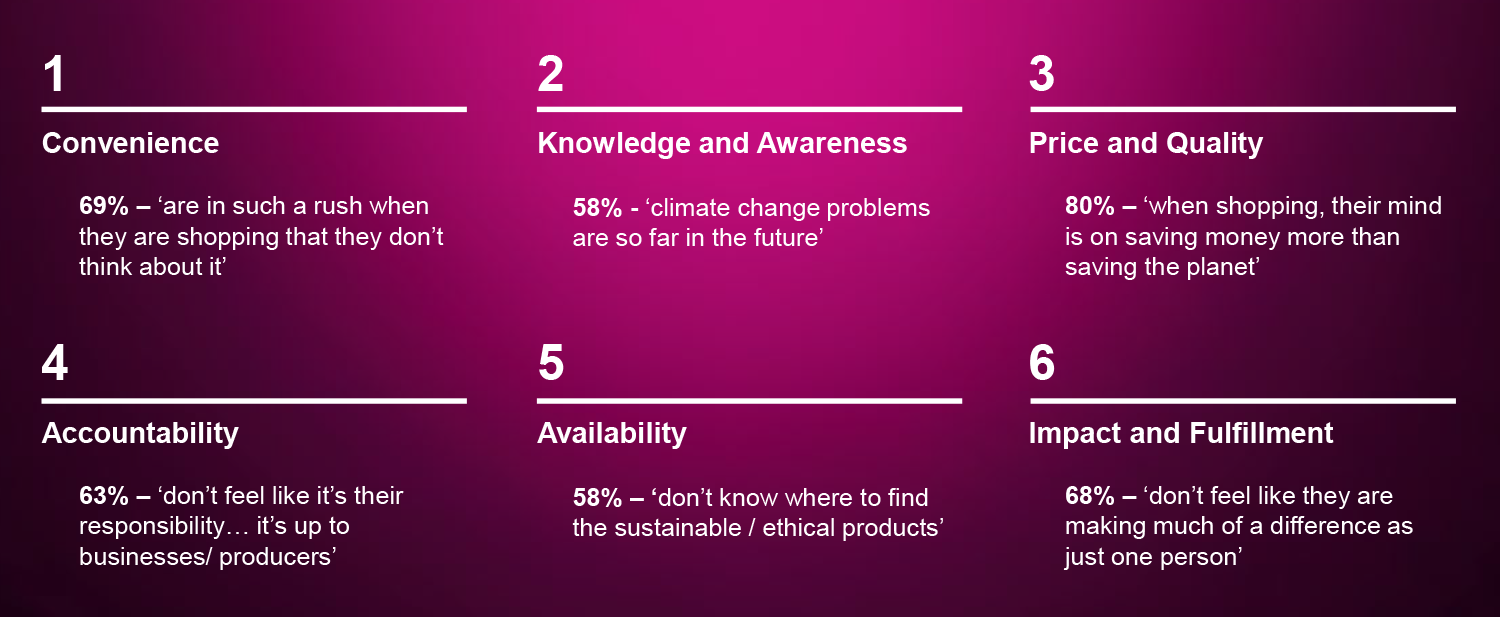Worldwide people care deeply about social and environmental issues. When we asked about these topics in our global Sustainability Sector Index study, the top concerns were water pollution, lack of clean and safe water and deforestation. And three-quarters of people (73%) say they try to factor sustainability into their purchase decisions at least once in a while.
People want to make a difference, but their value-driven concerns often don’t translate into action, a phenomenon we call the value-action gap. People feel driven to do something about environmental issues, but don’t always act on their intentions. There are many barriers that get in the way of sustainable living. 80% of people prefer saving money more than saving the planet when shopping, and almost one-third feel they, as a sole individual, can’t make a difference in saving our planet. And 58% believe climate change is so far in the future that they don’t feel compelled to act now.
Barriers to sustainable consumption

Source: Kantar Global Sustainability Sector Index 2021
Also, 63% of people around the world believe that it is businesses’ responsibility to act on climate change, not their own. So brands are faced with a challenging paradox. While people want to make a difference, they don’t see it as their job to lead. They look to brands, businesses and governments to do that.
How to encourage sustainable behavior
To find out how brands can encourage people to act on their intention to behave more sustainably, and ‘lead by example’, we reviewed academic and psychological literature on pro-social behavior (behavior supporting a greater purpose such as social and environmental issues). From this, using a behavioral science lens, we identified five ‘psychological levers’. Psychological levers are processes that influence our thinking and feelings in a subtle way, usually beyond our awareness.
With these levers in mind, we analyzed the most and least effective ads with sustainable or social messaging in our Link ad testing database along with Affectiva’s Emotion AI facial coding to uncover underlying feelings. We also tested a series of sustainable ads on Kantar Marketplace with Link Express with facial coding to explore the topic further.
The ads least effective in closing the value-action gap didn’t use or misused these psychological levers. For example, they presented sustainability as an abstract concept and didn’t empower the audience with concrete action steps towards sustainable living. And while humor is a powerful tool to drive effectiveness, some ads took humor too far, almost ridiculing sustainable living with the possible intention of making the topic more appealing this way.
The top performers, on the other hand, used one or more of the psychological levers to successfully bridge the value action gap and promote sustainable action.
The 5 psychological levers
Based on our analysis of the top and bottom performing ads we identified five main psychological levers that the best performing ads use to influence behavior.
1. Nature connectedness
People’s innate predisposition to connect and identify with the natural world. This inclination to connect with nature is so strong that we instinctively and unknowingly do our best to preserve nature. Many of the top performing ads used this lever. Seventh Generation’s Trees and B’s ad not only takes place in a garden, but the main hero even personifies a tree, calling him Mike, thereby amplifying nature connectedness. Grundig’s Washer Dryer – It starts at home ad impeccably marries white goods with the grace of nature.
2. Implementation intentions
A strategy in the form of an ‘if-then plan’ can increase the chances of goal achievement. Giving an ‘action plan’ to consumers is a powerful way of overcoming one of the biggest barriers to bridging the value-action gap (i.e. the feeling that one person is not enough to make a difference in sustainability). One of the best examples of this is Coca-Cola’s Ladybird ad, where the audience is given instructions on recycling in an endearing way, as an inscription on a bottle, ‘I can become another bottle when you recycle me. Thanks!' And by the way, adding ‘thanks’ ignites reciprocity, our inclination to be kind when we receive kindness, which further helps prompt sustainable action.
3. A sense of control
A sense of control is one of the levers of people’s innate motivation for psychological growth. When people feel they have the skills needed to achieve a goal, they feel they are in control, and are more likely to take action towards that goal. Google’s Helping everyone make sustainable choices ad provides concrete examples for people to help take sustainable actions: eco-friendly routing in Maps, the ability to sort flights based on CO emissions or choose eco-certified hotels. All these options empower the audience with ammunition to feel in control of their actions.
4. Mitigating present bias
People’s inclination is to focus on the here and now and prefer immediate rewards at the expense of long-term benefits. As this inclination often hinders us from translating our intentions into action, we want to mitigate this bias to bridge this gap. Miele’s Quality ahead of its time ad successfully overcomes the present bias by bringing the future benefits of using one, instead of many, appliances into the present. The creative achieves this without any didactic monologue, and in a subtle, nudging way, which is one of the best solutions to overcoming a bias that tends to operate under our conscious radar.
5. Social learning
Observing, modelling, and imitating the behaviors, attitudes and emotional reactions of people. While social learning is prominent in childhood, it doesn’t lose its significance in adulthood either. It can be achieved through role models, learning and also step-by-step ‘manuals’. This step-by-step demonstration, a form of social learning, is what makes Lurpak’s Where there are cooks ad powerful in prompting sustainable action. We witness how left-overs in the cupboard gain a new life by being re-purposed for a dish, whose preparation we witness in detail.
You might be wondering if one lever is more effective than another? It depends based on what your brand stands for, the message you want to convey and the creative execution you have chosen. All are effective in the right context. Also, people respond differently to sustainable messaging as Vera Sidlova points out in her article, 5 tips to get sustainable messaging right so the psychological levers should be tailored to your target audience. For example, ads may elicit different emotional responses from people with different levels of sustainability-commitment (high versus low). So before deciding on a psychological lever, we encourage you to gain clarity on these factors.
Uncovering emotions with facial coding and Kantar’s Link ad testing is a great way of diagnosing if your creative is able to close the value-action gap and encourage people to act sustainably. To ensure your ads perform well and move people from intention to action, explore your creative through the psychological levers, and an understanding of your target groups’ needs, values and sustainability mindset.
Watch our on-demand webinar to find out more about our research and the psychological levers that influence sustainable behavior. And please get in touch to discuss further.


